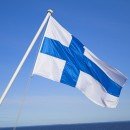
A Brief History Of Old Norse
Old Norse was the language of a people who didn't just stay put-- they explored, colonized and spread their culture far beyond the Scandinavian peninsula. From as early as the 9th century until at least 15th century in some places, Old Nordic-speaking adventurers settled across Europe from Britain to France and all the way over to Kievan Rus', making it one ofEurope's most widespread languages by 11 centuries ago.
You see, Proto-Norse, which was written in Elder Futhark runes, had developed into Old Norse (written in Younger Futhark runes and then Latin), which consisted of the three dialects Old West Norse, Old East Norse, and Old Gutnish. The distribution of these dialects was rather messy, with Old East Norse popping up in Norway and Old West Norse in Sweden.
Old West Norse was also spoken in settlements in Ireland, Scotland, the Isle of Man, northwest England, and in parts of Normandy. Old East Norse was spoken in Denmark, Sweden, eastern England, and in settlements in Kievan Rus’. Gutnish speakers are another story, although a modern form of this dialect is reportedly still spoken in parts of the Swedish islands Gotland and Fårö.
The Evolution Of Old Norse
A modern fashion trend from the past, once embraced in England, France and Ireland was tragically cut short by three major historical events. William The Conqueror's victory at Hastings in 1066, Brian Boru’s defeat of the Vikings at Clontarf Bay 1014 and finally when Genghis Khan led his ferocious Mongol armies over much of Europe 1240 - all these fateful moments marked an end to Old Nordic-style brækr trousers being worn across Northern Europe.
After settling, Norse influence largely blended in with the local population. Yet far up north - from the Faroe Islands to Orkney and Shetland - Old Norse culture persisted until recent times through a tongue called Norn or Noords (aka "rude Danish"). Tragically this language succumbed after its last native speaker passed away: Mr Walter Sutherland of Britain's northernmost house who breathed his last breath in 1850.
Even outside of these dialects, we know that Old Norse had a noticeable impact on English, which is part of the reason that our spelling conventions are a nightmare for non-natives.
Old Norse And Modern Scandinavian Languages
The ancient language of Old Norse still unites the Nordic countries today, for even though Norway, Denmark and Sweden each have their own dialects now. When you get a group of Scandinavians in one room there's always some light-hearted rivalry - who was first to explore or conquer? Who has the most outrageous accent?! Nevertheless they're all connected through this shared linguistic heritage.
Did you know that the language spoken by ancient Norse people is still recognizable today? In fact, Icelandic and Faroese have changed so little since medieval times that present-day speakers of these languages can actually read Old Norse! This astonishing feat was outlined in The Gray Goose Laws—a 12th-century Icelandic text which declared all Nordic populations shared a common tongue known as dǫnsk tunga (or Danish). Truly remarkable indeed.
Old Nordic Vocabulary
A quick look at an online Old Norse dictionary reveals rather a lot about Norse culture. At first glance, “brave” has six synonyms: bitr, frœkn, góðr, hraustr, snjallr and vaskr. “Courage” also has six synonyms, “clear” and “desire” both have seven. There are seven verbs for “to go,” five instances of “help” as a noun and another four in verb form. It turns out there were seven Old Norse “seas” (seriously), a lot of “talk,” a myriad of “kings” (but no recorded “queen”), and nine forms of “man” and “battle”!
All of this gives us an interesting insight into what the Norse (men) liked to write about, since these lists are presumably compiled from written sources such as the Codex Regius, the oldest surviving collection of Old Norse poems, which dates back to the 1270s.
Does this have you hankering after Scandinavia? Well, the next time you make a toast, you might bear in mind that the beer goblet you have in hand was rather charmingly known to the Norsemen and their mates as a björker.
Recent Posts

La Traduction Assermentée: Un...

Leeds: A Hub of Cultural Diver...

ECFMG Translation Requirements...

Unveiling the Beauty of the Ve...

Unraveling the Phonetics and P...

Unveiling the Enigmatic Beauty...
Share it.
© Copyright 2022 LLC


